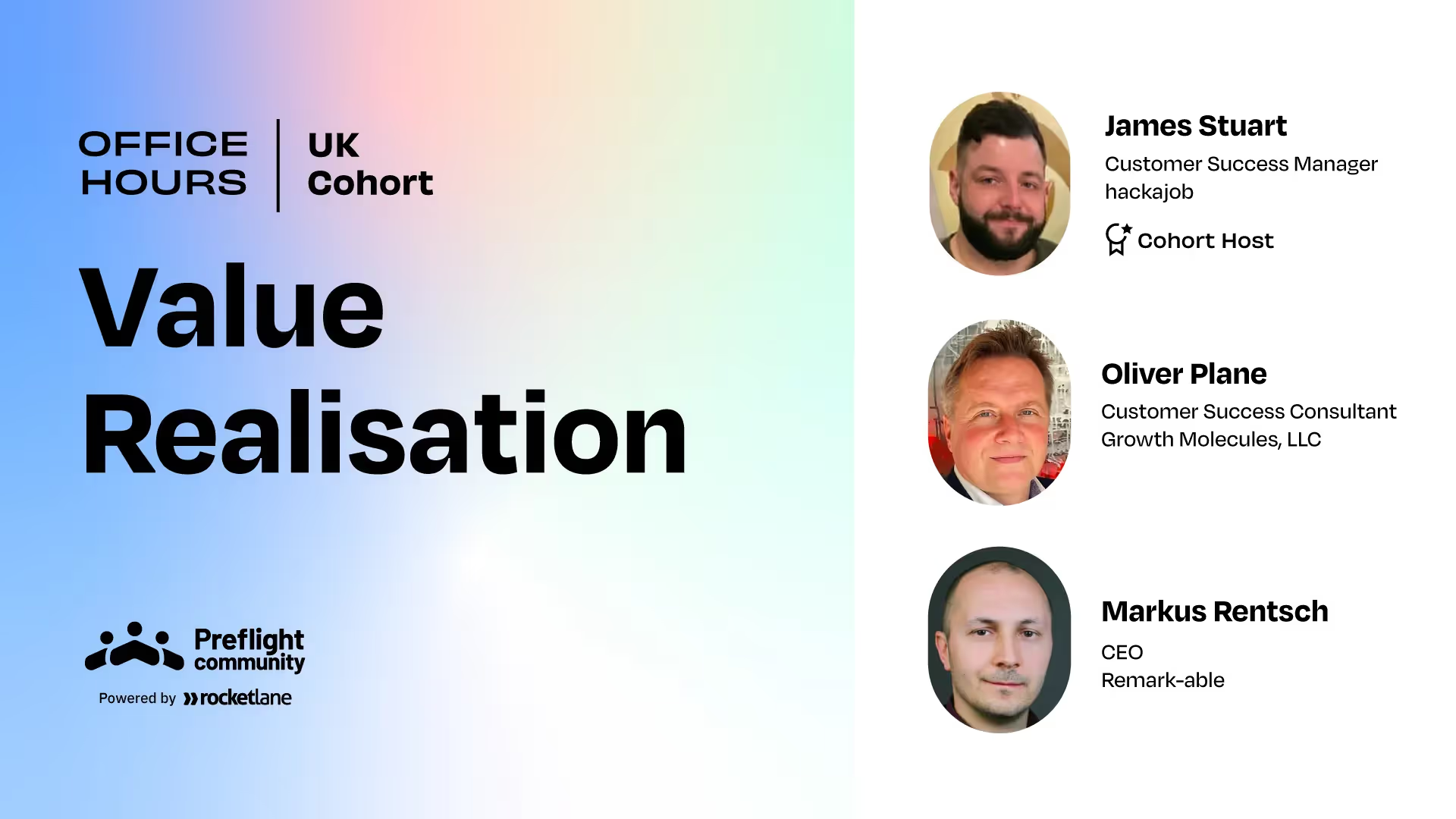In this session of Preflight UK’s Office Hours, James Stuart, CSM at hackajob spoke to Oliver Plane from Confluent and Markus Rentsch from Remark-able about product value, how customers can achieve value realization with your product, and how value realization can help find better solutions for customers.
Oliver, a top 100 CS Strategist 2021, currently works as an Enterprise Customer Success Executive at Confluent, a foundational platform for data-in-motion. Before Confluent, Oliver worked with Growth Molecules, a customer success consultancy, after working in the telecommunications, finance, and transport business sectors with companies such as Oracle, Logica, and others.
Markus is a customer success consultant and keynote speaker who helps SaaS companies use a Customer-Value-Led-Growth business model to eliminate churn, drive expansions, up-and cross-sells, and build better customer relationships.
The discussion focused on finding the answers to:
- What does value actually mean?
- How can you identify customer value?
- When and how can you deliver customer value?
- How can you set the right expectations for each customer?
Here are our top takeaways from the session.
1. Customer value is different things to different people
Different personas on the customer side perceive value differently. Knowing and understanding the ‘human’ outcome that these personas want and value the most is essential.
For example, the C-suite could value ROI while department heads could find value in freed up resources and fewer processes for innovation or other important projects; an individual contributor may see value in improving their day-to-day performance or productivity.
So while different personas may have aligned or similar goals, they view them differently, and it’s important to understand each of these perceptions.
2. Two questions to ask in a customer value discovery discussion
A mistake that companies often make is assuming they know what customers want.
Conduct a thorough discovery discussion with the customer to get answers to these two questions:
- What do they want?
- How do they measure it?
This creates a sense of accountability at the customer end and provides clarity and responsibility to the CS team.
And in cases where customers don’t have a concrete answer to these questions, it’s the CS team’s job to guide them to find this answer – drawing from their product expertise and experience with other/similar customers.
3. Identifying and validating customer value
Here are four steps the CS team must take to understand the customer’s needs, nail down their perception of value, and validate the value thus identified:
- Get inputs from the sales team: A thorough Sales-to-CS handoff is critical to understanding the key messages in the sales process and continuing them in the post-sale process. This can help better understand the customer better and speak their language.
- Build a solid relationship with the customer champion
- Research the customer using public domain information such as news reports, annual/financial reports, competition analysis, etc.
- Create the value messaging based on inputs from the above steps
- Validate the value messaging with the customer champion (on an ongoing basis)
4. Defining value in the pre-sales process
Though not always feasible, involving the CS team during the sales journey can be extremely helpful.
This way, customer value can be defined pre-sale – as a joint effort by Sales and Customer Success – so the CS team can:
a) Have the proper context and understanding of the customer’s needs
b) Set the right expectations for the customer
This can help minimize the risk of customers dropping off during onboarding – for no fault of the onboarding process.
5. Delivering value: What, when, and how
Value is continuously changing throughout that customer journey, and identifying the key phases in this journey can help identify what to deliver and when.
- Phase 1: Enablement (Deploying the solution/service). This needs to happen as smoothly and quickly as possible.
- Phase 2: Improvement. Looking at key business cases for improvement, such as the value of, say, automating a process, or reducing OpEx or CapEx, as perceived by the customer
- Phase 3: Innovation
Remember that the customer’s goals and visions will change over time. Validate the definition of value to the customer at every opportunity, especially critical ones like executive business reviews (EBRs).
6. Picking the right metrics to measure and capture customer value
The metrics that CS teams track and measure often have little to do with customer value.
For instance:
- NPS measures how customers feel about you/your product/service,
- Time to value helps the CS team understand the effectiveness and efficiency of the onboarding process
- Measuring usage/activity assumes that they're getting a lot of value, but this may not necessarily be true
The key is to demonstrate success in terms of the value customers receive. Simply put, always look at success as how the customer measures it, not necessarily how you measure it internally.
The customer champion has a crucial role to play here. In addition to helping you understand what value means to their organization, they need to:
- Validate the achievement of value
- Make this achievement apparent to their team and the rest of their organization
7. Managing multiple value perceptions within the customer’s team
While it can be challenging to manage and match up to different personas’ value perceptions, there is always a connection. The key is to explain and articulate how the different kinds of value add up.
A combination of solid leadership and deliberate communication can make this happen.
For instance, the internal leadership team can set up systems to:
- Talk to key stakeholders or personas at each level on the customer side
- Meet internally at a set cadence (say once a month) to share insights, identify connections, and understand any gaps in how these different personas perceive value
If you want to learn more about Customer Onboarding, Implementation, and Professional Services in-depth, join the Preflight Community.















